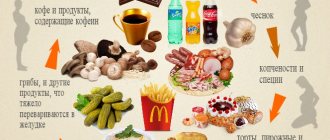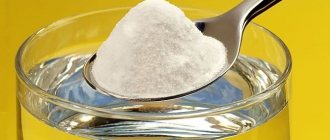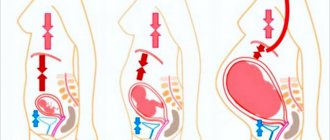Heartburn - every second pregnant woman has to deal with it. Most often it appears after the 20th week of pregnancy and remains until the birth of the child. One of the risk factors is the quantity and quality of food eaten. Therefore, the New Year holidays with parties at work and feasts at home may well provoke heartburn. What can you do to prevent or alleviate these sensations?
What is heartburn? Why does it occur in pregnant women?
Heartburn is a feeling of warmth or burning behind the breastbone that occurs some time after eating. Most often, heartburn appears in the evening. According to popular belief, it bothers the expectant mother when the baby's hair grows. In fact, heartburn occurs due to the reflux of acidic stomach contents into the lower esophagus. This happens because during pregnancy, the muscular sphincter located between the esophagus and the stomach relaxes under the influence of the hormone progesterone. Another cause of heartburn is that the enlarged uterus puts pressure on neighboring organs: the stomach, intestines. As a result, the volume of the stomach decreases, and even the usual amount of food can lead to its overflow and reflux of food back into the esophagus.
Causes of heartburn during pregnancy
Heartburn in pregnant women is a condition that is caused by changes that occur in the female body during pregnancy. All factors that can cause heartburn in women in an interesting position can be divided into physiological (natural) and pathological (associated with diseases).
Physiological heartburn in pregnant women can occur for two reasons:
- Hormonal – associated with weakening of the tone of the lower esophageal sphincter. This is the name of the circular muscle between the stomach and esophagus, which regulates the flow of food into the stomach and prevents its movement in the opposite direction. During pregnancy, the level of progesterone in the blood increases, which relaxes the uterine muscle, simultaneously acting on all other muscles of the body, including the esophageal sphincter. As a result, the sphincter does not close after eating, but remains open. Any change in body position or contraction of the stomach causes reflux of food4. Heartburn also occurs if the movement of food through the esophagus is disrupted, for example, if the frequency of “reverse” contractions of the esophagus in the direction from the stomach to the esophagus increases1.
- Physical – due to an increase in the size of the uterus, the location of internal organs changes and intra-abdominal pressure increases, which is transmitted to the wall of the stomach and promotes reflux4.
Due to such changes in the gastrointestinal tract during pregnancy, all pathologies that cause heartburn may worsen.
Pathological causes of heartburn during pregnancy include the following:
- Gastroesophageal reflux disease (reflux esophagitis) is a pathology of the esophageal sphincter, which occurs more often with a hernia of the diaphragm, when the natural bend between the esophagus and the stomach disappears, preventing reverse reflux4.
- Other diseases of the gastrointestinal tract are gastritis, peptic ulcer of the stomach and duodenum, pancreatitis, liver and biliary tract diseases, inflammatory bowel diseases2. With gastritis and ulcers, the acidity of the stomach increases, and pathologies of other digestive organs cause bloating, constipation, and enlarged liver, which increases intra-abdominal pressure.
- Taking medications that relax the lower esophageal sphincter - cardiac medications, theophylline, anti-inflammatory drugs, progesterone, antidepressants4.
Preventing heartburn during pregnancy
For mild cases of heartburn, doctors usually recommend diet and lifestyle changes. Here are a few rules that will help you avoid or reduce heartburn:
- Eliminate or reduce fatty, fried foods and chocolate in your diet, as these foods provoke additional relaxation of the esophageal sphincter.
- Eat small meals: 5–6 times a day at intervals of 1.5–2 hours and in small portions. Eat slowly, chewing your food thoroughly.
- Heartburn usually occurs in the first two hours after eating, so try not to lie down immediately after eating.
- Try sleeping on a bed with your head elevated (you can add another pillow).
Despite the fact that heartburn is quite unpleasant for the mother, it does not have any negative effect on the baby. Start your fight against heartburn with proper nutrition, and you may not need medications.
Heartburn and gastroesophageal reflux disease in pregnant women: the relevance of using alginates
Pregnancy is a normal physiological state for a woman, but its course may be accompanied by the development of a number of unpleasant symptoms, in particular, complaints from the gastrointestinal tract (GIT). Similar complaints include: nausea, mainly in the morning, and vomiting in the first trimester of pregnancy. Pregnant women may experience signs of gastric and intestinal dyspepsia, cholestasis, exacerbation of chronic cholecystitis, constipation-type bowel movements, as well as disturbances in the microflora of the digestive tube [1]. Most authors identify “pregnant heartburn” as a separate symptom that appears during pregnancy and is caused by it [2]. The relevance of the problem of heartburn in pregnant women is due to its high prevalence, association with the development of gastroesophageal reflux disease (GERD) and a decrease in quality of life.
According to the results of many scientific works, heartburn during pregnancy bothers 30–50%, according to some data, up to 80% of pregnant women [1, 3]. In a large-scale study, Naumann CR et al. When observing 2731 pregnant women, it was found that 95% of them experienced heartburn and/or nausea and vomiting [4]. As a rule, heartburn rarely bothers women in the first trimester (9.5%), more often occurs in the second trimester (43.1%) and is especially often observed in the third trimester (54.1%), is not pronounced and has a transient nature [ 5]. According to Burkov S.G., during an examination of 55 pregnant women, it was found that heartburn bothered 65.4% of them, and its prevalence in the first trimester was 7.2%, in the second - 18.2% and in the third - 40% [2].
Such a high prevalence of heartburn in pregnant women leads to the fact that many gynecologists consider it as a normal manifestation of pregnancy and do not attach much importance to it, while the appearance of heartburn may be a sign of GERD, requiring the prescription of medications, examination and observation.
An important observation is that pregnant women with complaints of heartburn are forced to resort to pharmacotherapy significantly more often than pregnant women with complaints of nausea and vomiting (47% versus 11%, respectively) [4].
If we talk about the postpartum period, it should be noted that not all women’s symptoms disappear without a trace. Thus, it was found that 19.7% of women who complained of heartburn during pregnancy also reported postpartum heartburn [4].
Factors predisposing to the development of heartburn in pregnant women, according to some authors, include: the presence of heartburn before pregnancy, multiple pregnancies, high body mass index before pregnancy and significant weight gain during pregnancy [4]. Women who prefer meat foods suffer from heartburn more often during pregnancy compared to vegetarians [5].
The causes of complaints of heartburn in pregnant women can be divided into two categories: physical (mechanical) and hormonal.
The main hormonal mechanism for the development of heartburn in pregnant women is considered to be a decrease in the tone of the lower esophageal sphincter as a result of the action of progesterone [6]. In almost all women, the tone of the lower esophageal sphincter decreases by the 36th week of pregnancy and is restored after childbirth [6]. Under the influence of gestational hormones, the tone of intestinal smooth muscles decreases, and the sensitivity of intestinal chemoreceptors to serotonin and histamine is disrupted. These factors lead to a decrease in intestinal motility, and subsequently potentiate the development of not only constipation and disruption of the intestinal microflora, but also a violation of the evacuation of acidic contents from the stomach and the occurrence of acid reflux.
Physical reasons include: an increase in the size of the uterus, which results in a disruption of the relative position of internal organs and an increase in intra-abdominal pressure and pressure in the stomach. In addition, if the location of the abdominal organs is disturbed, the stomach moves towards the diaphragm, the function of the lower esophageal sphincter is disrupted and the risk of developing a hernial protrusion of the stomach into the esophageal opening of the diaphragm increases. The peristalsis of the large intestine also decreases and the removal of acidic contents from the stomach is delayed [6].
Heartburn in pregnancy and GERD in pregnant women
Heartburn may first begin to bother a woman during pregnancy, increase as pregnancy progresses, and disappear after childbirth, but in some cases, heartburn is regarded as a symptom of GERD, which had previously bothered the patient [1]. In the development of heartburn in pregnancy and GERD there is one main mechanism - weakening of the tone of the lower esophageal sphincter. This dictates the need in some cases to talk not about heartburn, but about GERD in pregnant women.
According to the definition, GERD is a chronic relapsing disease caused by the entry of gastric and/or intestinal contents into the esophagus, regardless of whether inflammation of its mucous membrane develops or not. Therefore, when managing pregnant women, it is necessary to take into account that in patients with GERD preceding pregnancy, there is a high probability of worsening the course of the disease during pregnancy. At the same time, the occurrence of heartburn during pregnancy can be considered a risk factor for the development of GERD after childbirth. Thus, in a study by Turkish scientists, it was found that if heartburn occurs during at least one pregnancy, the risk of subsequent development of GERD was 17.7%, and during more than two pregnancies - 36.1%. Moreover, the risk of developing GERD did not depend on age or obesity [7].
In diagnosing GERD, a thorough history is important. Typical manifestations of GERD: complaints of heartburn, worsening after eating, after eating foods that weaken the tone of the lower esophageal sphincter (animal fats, alcohol, coffee, chocolate, citrus fruits), in a lying position, when bending over, and the presence of any equivalents of heartburn that occurs when under the same conditions, allow a diagnosis of GERD to be made without endoscopic examination. Clinically, patients with GERD, in addition to heartburn, may be bothered by atypical symptoms of the disease, or equivalents of heartburn. Thus, Spanish scientists, when examining 263 pregnant women, found that non-cardiac chest pain bothered 9.1%, dysphagia - 12.6%, feeling of a lump in the throat - 33.1%, cough - 26.6%, belching - 66. 2% and hiccups - 19.0% of women [8].
It should be noted that in pregnant women, severe complications of GERD are quite rare, as a result of which fibroesophagogastroduodenoscopy (FEGDS) is not necessary for all pregnant women with heartburn [3]. The group of patients in need of FEGDS includes women with severe complaints (heartburn, disturbing several times a day, difficult to relieve with antacids), with a previous severe course of GERD (III–IV degree according to the Los Angeles classification), with an indication in history for the development of complications of GERD (esophageal ulcers, bleeding from the esophagus, Barrett's esophagus).
If necessary, endoscopic examination can and should be carried out in pregnant women (according to indications) at any stage. This method, when performed correctly and carefully, is safe for the mother and fetus. Contraindications to performing FEGDS may be: deformation of the cervicothoracic spine, pronounced curvature of the spine (kyphosis, scoliosis, lordosis), narrowing of the esophagus, pharyngeal rigidity, large goiter, excessive vomiting of pregnant women, nephropathy in pregnancy, eclampsia or preeclampsia, placenta previa [2 ]. When conducting an endoscopic examination, it is necessary to determine the type of GERD according to the clinical endoscopic classification: endoscopically negative or non-erosive reflux disease (including catarrhal esophagitis), or endoscopically positive or erosive reflux disease: degree AD according to the Los Angeles classification (including complications), i.e. Because treatment tactics depend on the course of GERD.
Intraesophageal 24-hour pH monitoring and esophageal manometry are rarely used in pregnant women. X-ray examination of the esophagus and stomach is prescribed only for health reasons due to the high risk to the fetus.
Treatment of women with pregnancy heartburn and GERD should be comprehensive and combine dietary recommendations, lifestyle modifications and medications.
Recommendations for diet and lifestyle changes are as follows:
1) fractional meals; 2) consumption of products that have an alkaline reaction (milk, sour cream, cottage cheese, steam omelettes, boiled meat); 3) avoid large meals and not eat at night; after eating, avoid bending forward and not lying down; limit the consumption of foods that reduce the tone of the lower esophageal sphincter and have an irritating effect on it (animal fats, alcohol, coffee, chocolate, citrus fruits, rye bread, carbonated drinks); 4) do not wear tight clothes and a tight belt; 5) quitting smoking, because nicotine weakens the tone of the lower esophageal sphincter; 6) prevent the development of persistent constipation in order to avoid an additional increase in intra-abdominal pressure; 7) if possible, limit the intake of medications that cause reflux (anticholinergics, sedatives, tranquilizers, calcium channel inhibitors, beta-blockers, theophylline, prostaglandins, nitrates); sleep with the head of the bed raised; 9) avoid prolonged bending; 10) avoid performing gymnastic exercises associated with tension in the abdominal muscles.
The peculiarities of pharmacotherapy for GERD in pregnant women are that most antisecretory drugs indicated for this pathology penetrate the hematoplacental barrier and can be potentially dangerous to the fetus. An important criterion for the possibility of using drugs during pregnancy are the recommendations of the US Food and Drug Administration (FDA), one of the world's leading organizations for studying drug safety (Table 1).
From the presented table it is clear that among the above-mentioned drugs there are no absolutely safe drugs for use during pregnancy. It should be noted that the use of class B drugs, especially prokinetics, must be carried out according to strict indications and under constant monitoring, including due to the risk of developing side effects. Thus, the use of H2 blockers is accompanied by the development of “withdrawal syndrome,” and when using PPIs, bacterial overgrowth syndrome may develop due to a sharp decrease in the bactericidal ability of gastric juice; reverse increase in the secretion of hydrochloric acid due to an increase in the concentration of the hormone gastrin in the blood according to the feedback principle; disturbance of calcium absorption [10, 11]. The use of drugs from the antacid group gives a quick but short-term effect and may also be accompanied by the development of a number of negative effects. So, in 1977 W. Kaehny et al. found increased levels of aluminum in plasma and urine after taking aluminum-containing antacids in people with normal renal function, whereas it was previously thought that it was not absorbed orally [12]. According to Berthon G., 2002, when aluminum hydroxide, which is part of antacids, interacts with acid in the stomach, from 17% to 30% of the resulting aluminum chloride can be absorbed [13].
Thus, the search for new drugs for the treatment of GERD in pregnant women remains relevant. Significant prospects in this regard may be based on the introduction of alginates into treatment regimens - a group of drugs based on alginic acid obtained from marine brown algae, in particular from Laminaria hyperborea. Alginic acids (from Latin alga - sea grass, algae) are polysaccharides, the molecules of which are built from residues of beta-D-mannuronic and alpha-L-guluronic acids, which are in pyranose form and linked in linear chains by 1->4-glycosidic connections [14]. Blocks built from polymannuronic acid impart viscosity to alginate solutions, guluronic acid blocks are responsible for gel strength and specific binding of divalent metal ions.
The safety of alginates has been assessed by The Joint FAO/WHO Expert Committee on Food Additives (JECFA), Food and Agriculture Organization (FAO)/World Health Organization , WHO)), which established acceptable daily intake as “unrestricted” for alginic acid and its salts, and has been confirmed in numerous studies [14]. Numerous toxicological studies conducted around the world in the 40–70s of the twentieth century confirmed the safety of the use of alginates, in particular sodium alginate.
Well-known representatives of alginates are Gaviscon and Gaviscon forte, which differ in the quantitative content of individual components. The main anti-reflux mechanism of their action is the formation of a mechanical barrier-raft (sodium alginate), which prevents the reflux of stomach contents into the esophagus. At the same time, the mechanism of hydrochloric acid production in the stomach, and therefore the digestion process, is not disrupted. The potassium bicarbonate contained in Gaviscon Forte, being a source of CO2, gives the raft “buoyancy”, while calcium carbonate binds long alginate molecules to each other to strengthen the resulting protective barrier. In addition to the antireflux effect, alginates have a number of useful effects that ensure their effectiveness in the treatment of GERD: prokinetic, enveloping, mild laxative, cytoprotective, hemostatic effect.
In a generalized form, the place and properties of alginates using the example of the drug Gaviscon among other drugs used for the treatment of acid-related diseases of the digestive system, including GERD, are presented in Table. 2.
The effectiveness of Gaviscon Forte has been confirmed in a number of studies, including with the participation of pregnant women. Thus, in an open, multicenter study of 150 pregnant women with heartburn at 38 weeks or less, it was revealed that the administration of Gaviscon Forte in a course for 4 weeks resulted in relief of symptoms in 90% of women [15]. The work of other scientists showed that the administration of Gaviscon Forte to 50 pregnant women for 1 month contributed to a significant reduction in the frequency, duration and intensity of complaints in 98%. The drug was remarkably tolerated by women [16].
According to our research, the use of Gaviscon Forte suspension in a standard dosage: 10 ml after meals 3 times a day and 10 ml at night for 14 days improves 24-hour pH monitoring and significantly reduces the percentage of time with intragastric pH less than 2 at night in most patients with GERD (Table 3) [17].
During treatment, there was almost complete relief of epigastric pain, which occurred in a number of patients, and the disappearance of clinical symptoms of GERD within 2–3 days. Most patients noted the good organoleptic properties of Gaviscon Forte. During treatment, no side effects of the drug or allergic reactions were recorded, which once again proves its high safety.
Therefore, it will be rational and justified to begin therapy for GERD in pregnant women with the use of alginates. The treatment algorithm for pregnant women with heartburn and GERD is presented in Figure [6, as amended].
When discussing this algorithm, it should be noted that the use of antacids containing magnesium and aluminum salts during pregnancy should still be limited due to the existing likelihood of their absorption and the risk of negative effects on the fetus. Among antisecretory drugs, H2-histamine blockers have a less pronounced acid-suppressive effect than proton pump inhibitors; in addition, they are characterized by the “rebound” phenomenon, i.e. withdrawal syndrome. Therefore, the prescription of H2-histamine blockers should only be carried out when it is impossible to use proton pump inhibitors, for example, due to their intolerance.
In conclusion, it should be emphasized that due to their high safety profile and effectiveness, alginates, in particular Gaviscon Forte, are indicated for use as monotherapy, especially for non-erosive reflux disease, which is extremely important for pregnant women with limited choice of medications. At the same time, Gaviscon Forte can be used for the erosive version of GERD, in combination with other antisecretory drugs.
Literature
- Elohina T. B., Tyutyunnik V. L. Gastroesophageal reflux disease during pregnancy // Experimental and clinical gastroenterology. 2009. No. 3. pp. 93–97.
- Burkov S.G. Heartburn in pregnant women // Gynecology. Supplement to the journal Consilium medicum. 2004. T. 6, No. 2 [electronic resource]: URL: https://old.consilium-medicum.com/media/gynecology/04_02/76.shtml (access date 11/12/2012).
- Richter JE Gastroesophageal reflux disease during pregnancy // Gastroenterology Clinics in North America.//2003. Vol. 32(1). P. 235–261.
- Naumann CR, Zeling C., Napolitano PG, Ko CW Nausea, vomiting, and heartburn in pregnancy: a prospective look at risk, treatment, and outcome // The Journal of Maternal-Fetal and Neonatal Medicine. 2012. Vol. 25 (8). P. 1488–1493.
- Ramu B., Mohan P., Rajasekaran MS, Jayanthi V. Prevalence and risk factors for gastroesophageal reflux in pregnancy // Indian Journal of Gastroenterology. 2011. Vol. 30(3). P. 144–147.
- Richter JE Heartburn, nausea, vomiting during pregnancy. Pregnancy in Gastrointestinal disorders. American college of Gastroenterology. pp. 18–25. [electronic resource]. URL: https://beepdf.com/doc/164463/pregnancy_in_gastrointestinal_disorders.html (accessed November 13, 2012).
- Bor S., Kitapcioglu G.., Dettmar P., Baxter T. Association of heartburn during pregnancy with the risk of gastroesophageal reflux disease // Clinical Gastroenterology and Hepatology. 2007. Vol. 5 (9). P. 1035–1039.
- Rey E., Rodriguez-Artalejo F., Herraiz MA et al. Atypical symptoms of gastro-esophageal reflux during pregnancy // Revista Espanola de Enfermedales Digestivas. 2011. Vol. 103(3). P. 129–132.
- Pregnancy category [electronic resource]. URL: https://en.wikipedia.org/wiki/Pregnancy_category (accessed November 16, 2012).
- Laheij R., Stukenboom M., Nassing R. et al. Risk of community-acquired pneumonia and use of gastric acid-suppressive drugs // JAMA. 2004. Vol. 292. P. 1955–1960.
- Yang Y., Lewis J., Epstein S., Metz D. Long-term proton pump inhibitor therapy and risk of hip fraction // JAMA. 2006. Vol.296. P. 2947–2953.
- Berthon G. Aluminum speciation in relation to aluminum bioavailability, metabolism and toxicity // Coord Ghem Rev. 2002. Vol. 228. P. 319–341.
- Kaehny W., Hegg A., Alfrey A. Gastrointestinal absorption of aluminum from aluminum-containing antacids // N Engl J Med. 1977. Vol. 296. P. 1389–1390.
- Vasiliev Yu. V. Gaviscon as an alginate derivative in the treatment of gastroesophageal reflux disease // Russian Medical Journal. 2012. No. 15 [electronic resource]. URL: https://www.rmj.ru/articles_8299.html (accessed November 16, 2012).
- Lindow SW, Regnell P. Sykes J., Little S. An open-label, multicentre study to assess the safety and efficacy of a novel reflux suppressant (Gaviscon Advance) in the treatment of heartburn during pregnancy // International Journal of Clinical Practice. 2003. Vol. 57(3). P. 175–179.
- Uzan M., Uzan S., Sureau C., Richard-Berthe C. Heartburn and regurgitation in pregnancy. Efficacy and innocuousness of treatment with Gaviscon suspension // Revue Francaise de Gynecologie et d'Obstetrique. 1988. Vol. 83 (7–9). P. 569–572.
- Uspensky Yu. P., Pakhomova I. G., Tkachenko E. I. The first experience in Russia of using Gaviscon in the treatment of gastroesophageal reflux disease // Russian Medical Journal. 2007. T. 15, No. 22. P. 1–4.
Yu. P. Uspensky, Doctor of Medical Sciences, Professor N. V. Baryshnikova, Candidate of Medical Sciences, Associate Professor
GBOU VPO SPbSMU im. I. P. Pavlova, St. Petersburg
Contact information for authors for correspondence
Home remedies for heartburn in pregnant women
You can also try using folk remedies for heartburn, the only important thing is that they are safe. For example, milk helps a lot with heartburn ; just a few sips and the unpleasant burning sensation goes away. Grapefruit and carrot juice have the same effect . You can get rid of heartburn with the help of various nuts (walnuts, hazelnuts, almonds), but they are more likely to prevent heartburn than eliminate existing ones. seeds help someone cope with heartburn , but here, as with nuts, one must observe moderation. A few nuts or grains are great, but you shouldn’t eat kilos of them, they contain a lot of fat and are very high in calories.
Nadezhda Desnitskaya, a specialist in natural childbirth and a healthy lifestyle while expecting a child, advises:
Get used to eating fractionally, distributing your entire daily amount of food into 5-6 meals. Give preference to everything fresh and natural to get rid of intoxication.
Herbal recipes
If heartburn occurs, the expectant mother may well use the following recipes, which are based on medicinal herbs:
Calamus root (a tablespoon) needs to be crushed and poured with boiling water. Leave to infuse for 7-10 minutes, then strain and drink a sip before each meal.- Heather (a tablespoon) should be poured with a glass of boiling water and simmer for several minutes over low heat. Then you will need to strain the broth and drink 1 tbsp. spoon, three times throughout the day.
- Pour 1/2 teaspoon of wormwood into half a glass of water and leave to infuse in a warm place. After two days, the broth should be strained and drunk, divided into two doses.
- A couple of tablespoons of dried mint should be poured with boiling water and brewed like ordinary tea. Add a couple of currant and viburnum leaves. It is recommended to drink 3 glasses of this healing drink throughout the day.
Please note: medicinal herbs such as dill, St. John's wort, buckwheat and plantain provide a good therapeutic effect in the fight against heartburn. Decoctions of these plants can be drunk daily, instead of the usual tea!
Note that not all herbs recommended by traditional medicine for heartburn are equally safe for a woman expecting a baby, so it is advisable to coordinate the course of herbal medicine with your doctor!
Use with caution
It is advisable for the expectant mother, if possible, not to take antispasmodics (drugs that relieve spasms of smooth muscles of internal organs) unnecessarily, for example, No-shpu, Papaverine, as they relax the esophageal sphincter and thus contribute to the occurrence of heartburn. Some herbs, such as mint, have the same effect.
Baking soda is often used for heartburn. It really helps to relieve the unpleasant burning sensation very quickly, but at the same time it does not last long. In addition, when soda interacts with gastric juice, carbon dioxide is formed, which has a strong soda effect - as a result, new portions of hydrochloric acid are produced, and heartburn resumes. It should be borne in mind that the sodium contained in baking soda is absorbed in the intestines and can lead to the appearance of edema, and this is completely undesirable for expectant mothers.
Important!
Olesya Molodkina, a gastroenterologist of the 1st category, warns:
You cannot regularly take soda for heartburn, as this disrupts the ratio of salts and water in the body.
Why is this happening
With the development of science and medicine, heartburn is no longer associated with the growth of hair and nails in a child in the womb. Now heartburn at any stage of pregnancy is explained by scientific arguments.
1st trimester
Heartburn in the early stages is often a consequence of stomach diseases before pregnancy. Planning conception and careful preparation for this event helps prevent this problem. The second common provocateur is toxicosis. The first 12-16 weeks of toxicosis are present in most women. Often a feeling of mild nausea is accompanied by heartburn. It also occurs against the background of severe toxicosis, if the expectant mother often vomits.
The hormonal factor in heartburn is progesterone levels. It rises sharply after conception and only continues to rise as pregnancy progresses. Progesterone has a relaxing effect on smooth muscles. It is these muscles that make up the lower esophageal sphincter, which blocks the “entrance” to the stomach. Relaxation of the sphincter provokes regular reflux of chyme into the esophagus.
2nd trimester
In the middle of pregnancy, the hormonal provoking factor does not lose relevance, but other possible provocateurs also join in.
The first is the excessive aggressiveness of the acidic gastric environment. Simply put, it increases the acidity of gastric juice. Women who have “survived” toxicosis often return to their favorite dishes. Taste preferences change. Pregnant women's favorite foods - chocolate and pickled foods - can cause heartburn even in an ordinary person.
Another common factor is motor impairment. Pregnant women often experience intestinal problems (constipation, bloating) and enzymatic deficiency. This contributes to the retention of a bolus of food in the stomach with subsequent reflux into the esophagus (for example, during physical activity).
3rd trimester
In late pregnancy, heartburn is provoked by purely mechanical pressure on the stomach by the child growing inside. At this stage of gestation, the baby occupies most of the space in the abdominal cavity, putting pressure on the internal organs and the diaphragm. With increased pressure on the stomach, reflux occurs, even if the woman has never suffered from heartburn before.
Information from medical statistics: heartburn occurs in 11% of pregnant women in the 1st trimester, in 25% in the 2nd trimester, and in 72% of pregnant women in the 3rd trimester.
What can pregnant women do for heartburn? Safe medications
During pregnancy, you can use so-called antacid medications . These medicines contain magnesium and aluminum salts. They neutralize the acid that is part of the gastric juice, form a protective film on the wall of the stomach, and increase the tone of the lower esophageal sphincter. Nowadays, Maalox, Almagel, Rennie, Gaviscon are most often used. A side effect of some antacids is constipation (due to calcium or aluminum salts), and magnesium, on the contrary, has a laxative effect. Therefore, you should not use these drugs for a long time. When taking antacids, be aware that they may interfere with other medications. Therefore, some time should pass between taking antacids and other drugs.
How to be a future mother
If you experience 2 attacks of heartburn, you should tell your obstetrician-gynecologist. The specialist will recommend an acceptable way to get rid of discomfort “for the future.” Usually the doctor recommends antacid medications. However, they cannot be taken on a regular basis, since medications change the balance of electrolytes and remove useful minerals. If a woman experiences heartburn regularly, every effort should be made to make attacks (and medications, respectively) as infrequent as possible. To combat heartburn, you need to make a plan.
We are looking for the “culprit”
A pregnant woman should monitor what causes a burning sensation. Common reasons:
- binge eating;
- physical activity immediately after eating;
- staying in a lying position after eating;
- consumption of chocolate, sour, fried, fatty, fermented milk products;
- drinking carbonated drinks;
- rapid absorption of food;
- straining when going to the toilet;
- “generous” addition of spices to food products;
- sitting pose with dropped shoulders and arched back.
By identifying the provocateurs, a woman will be able to take complete control of her heartburn.
It is not uncommon to experience heartburn when eating a specific type of food: ice cream, citrus fruits, baked goods, fibrous or essential oil vegetables.
Adjusting your lifestyle
There are already many changes going on in the life of an expectant mother, but the appearance of heartburn indicates an additional need to revise the daily routine and usual actions. You can get rid of heartburn by making it a habit:
- sit and walk with a straight back;
- chew food thoroughly;
- eat in small portions, but often;
- drink water 30-40 minutes after eating;
- go for a walk after eating;
- eat your last meal 3-4 hours before bedtime;
- drink enough water;
- eat fresh vegetables often;
- drink regular milk regularly;
- rest in a half-sitting position;
- squat, holding onto a support, instead of bending the body.
It is necessary to reconsider the diet. You should exclude from it all foods that provoke the production of hydrochloric acid and can cause heartburn. It is better for a pregnant woman to avoid butter dough, sweet pastries, and dark varieties of bread. It is necessary to exclude smoked meats, sausages, salty and pickled foods, fatty foods, sour fruits, garlic and onions, radishes and radishes. Also, during the period of bearing a child, you should avoid sweets, tea, coffee, and carbonated drinks with dyes.
Eliminating heartburn using traditional methods
A pregnant woman can prevent and stop an attack of heartburn with the help of products. Potato juice reduces acidity well. It is consumed one tablespoon every 30 minutes until the symptom disappears. Boiled and slimy porridges - oatmeal, semolina, rice - cope well with discomfort. You can relieve nausea and heartburn with mint tea: pour a teaspoon of dried herb into a glass of boiling water and drink the infusion in small sips as heartburn worsens. People of the older generation recommend that pregnant women consume natural homemade jelly with berries and fruits more often. Among herbal remedies, pregnant women can take an infusion of flax seeds.
For quick-acting products, you can use regular seeds or nuts. A small handful will distract and relieve heartburn, and roughage also stimulates the tone of the esophageal sphincter. Traditional healers also recommend that pregnant women eat dry cookies or a crust of bread 10 minutes after eating.
A well-known remedy for heartburn is carrot juice. A pregnant woman can drink the drink at the first signs of heartburn. Juice should not be taken with food. Additional stretching of the stomach walls will only worsen the problem.
There are recommendations for taking decoctions of centaury, heather, lemon balm, and plantain. Herbal medicines or herbs should be used as recommended by a doctor. Even if the plant has been tested by numerous friends, you must tell your doctor about taking it.
Pharmacy drugs
To relieve heartburn, either drugs officially approved for use in pregnant women (as prescribed in the instructions) or drugs prescribed by a doctor are used. Treatment is carried out exclusively in case of exacerbation of gastritis or peptic ulcer with special antisecretory agents, which are also selected by the doctor.
Antacids that can be taken by pregnant women should belong to the non-absorbable group. These are drugs that act exclusively in the lumen of the esophagus and stomach, without being absorbed into the systemic bloodstream. All antacids are made on the basis of calcium, magnesium, and aluminum salts.
Symptomatic therapy should not be permanent. Some salts cause constipation, have sorption properties, and remove beneficial substances from the body. The following drugs have proven safety for the fetus and mother:
- Rennie. Local tablets based on carbonate salts of magnesium and calcium. They act in the lumen of the stomach, reacting with hydrochloric acid. Absorbed by only 10%, without changing the electrolyte balance. Officially approved for pregnant women. The effect develops within 3-5 minutes.
- Gaviscon. A drug with proven safety for pregnant women and the fetus. The combined composition includes calcium and sodium carbonate salts, sodium alginate - an extract from brown algae that can acquire a gel-like consistency. Alginate forms a gel on the surface of the chyme, preventing it from refluxing into the esophagus, and other components reduce the acidity of the environment in the stomach. It works in 5-10 minutes.
- Maalox. Contains aluminum and magnesium hydroxides. Acts as an antacid, enveloping agent and sorbent. Eliminates heartburn quickly, does not have teratogenic properties. Pregnant women should be prescribed by a doctor. Admission during gestation should be reasonable and periodic. With regular use and exceeding doses, vitamin deficiency and electrolyte imbalance are possible.
- Phosphalugel. Liquid preparation based on aluminum phosphate. Envelops the mucous membrane, adsorbs harmful substances and quickly neutralizes hydrochloric acid. Pregnant women can use as prescribed by a doctor. When taken regularly, it removes beneficial substances and causes constipation.
In the fight against heartburn, the expectant mother should start with the safest methods - lifestyle and menu adjustments. If innovations are ineffective, you can enrich your diet with foods that reduce the symptoms of heartburn. If the effect is weak or absent, you should consult a doctor to select a herbal or chemical antacid drug. You should not use medications on your own so as not to harm the baby or cause pregnancy complications.
Additional prevention rules
Heartburn in the last weeks of pregnancy requires a woman to be aware of what and how she is doing. For example, if a pregnant woman slouches, often bends over, or remains in an inclined position for a long time, a burning attack cannot be avoided. If your condition allows, it is advisable to often be in the fresh air, and take short walks before going to bed.
Pregnant women should never resort to a method such as drinking soda. It will relieve the condition only for a short time, but later it will provoke a strong, prolonged attack.
A woman in a special position is obliged to lead a healthy lifestyle. Then she will be able to alleviate, or even completely avoid, such an unpleasant symptom as heartburn at 40 weeks of pregnancy or earlier.
What else to read:
- Getting rid of heartburn on your own Many people are often bothered by heartburn - an unpleasant burning sensation in the epigastric region and behind the sternum. The cause of its appearance may be disturbances in the functioning of the digestive system, as well as increased……
- What foods trigger heartburn? Contents of the article:1 Why heartburn occurs2 What foods cause heartburn most often3 Foods that are allowed for consumption4 What you can eat in limited quantities5 What pregnant women can eat when everything is not allowed Foods that cause heartburn……
- How to quickly get rid of heartburn using folk remedies Contents of the article:1 Why heartburn occurs2 What to drink for heartburn at home2.1 Soda2.2 Vegetable oil2.3 Dairy products2.4 Herbal medicine2.5 Other remedies3 Products that eliminate burning4 Quick-acting medications4.1 Antacids4.2 Antisecretory means5 Dangerous……










